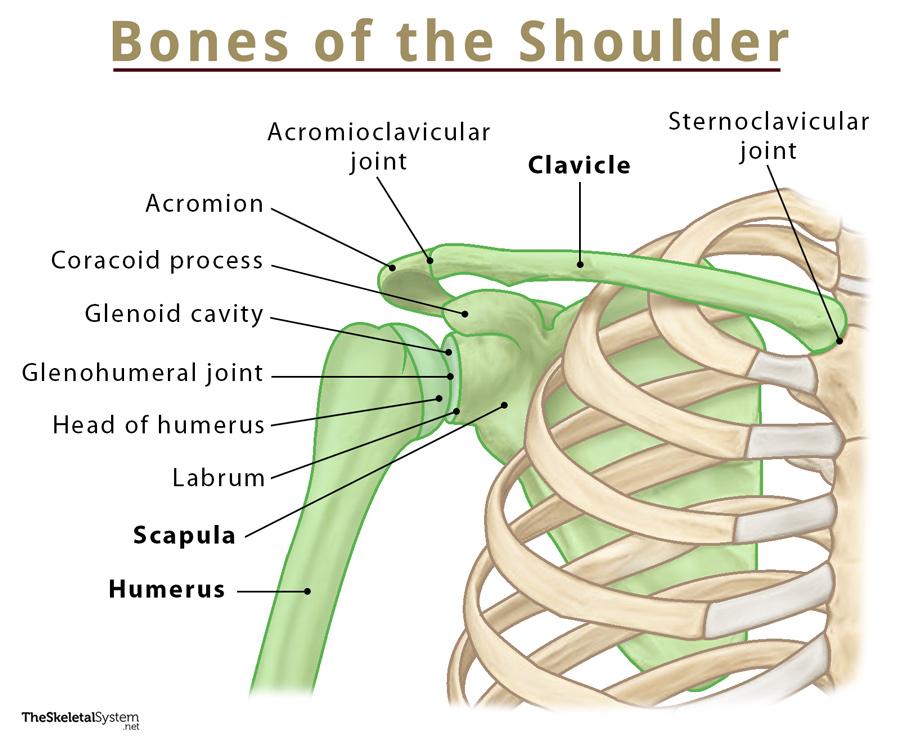Shoulder Bones
The shoulder is one of the major joints in the human body, involved in almost all arm movements. Although often referred to simply as the shoulder joint, it is a complex structure formed by a combination of multiple bones, joints, and muscles. All of these work together and allow us to move our shoulders to raise our hands, reach behind our backs, or throw something.
Names of the Bones in the Shoulder with Basic Anatomy
The following 3 bones are involved in the formation of the shoulder:
- Scapula (shoulder blade): The large flat bone at the upper back, it serves as the attachment point for multiple muscles like the trapezius, pectoralis major, and deltoid. It is the connection between the other two bones in the shoulder region. The scapula also helps the humorous to stay in place.
- Clavicle (collarbone): This thin long bone is the connection between the arm and chest. The scapula and clavicle together form the pectoral girdle that connects the appendicular and axial skeletons.
- Humerus (upper arm bone): The only bone in the upper arm, it is the connection between the shoulder and the elbow. The head, or proximal part of the humerus, acts as the ball for the biggest ball and socket joint at the shoulder.
Important Bony Landmarks
Being one of the biggest bony structures, there are several landmarks in this region. The most prominent and structurally important ones are all part of the scapula:
- Acromion: It is an elongated flat projection off the scapula pointing towards the front of the body, marking the roof, or the point at the top of the shoulder. The acromion is where the scapula articulates with the clavicle and gives the shoulder the squarish shape.
- Coracoid Process: A thick hook-like elongation projecting towards the front, it is an vital point of attachment to several muscles and ligaments that support the clavicle and humerus, allowing the shoulder joint and upper arm to function.
- Glenoid Cavity: This is the shallow cavity on the lateral side of the scapula that functions as the socket for the ball and socket shoulder joint. There is a cartilaginous structure called the labrum that rims the cavity to create a ‘cup’ to securely hold the humeral head.
Joints and Articulations
The human shoulder is formed primarily by two joints:
- Glenohumeral Joint: The joint you think about when you think of the shoulder, it is a major ball and socket joint between the head of the humerus and the shoulder socket or glenoid cavity of the scapula. Being a ball and socket joint, it allows the arms to move in their circular motions.
- Acromioclavicular Joint: This is the second most important joint in the shoulder, forming where the clavicle or collarbone meets the acromion of the scapula. Also called the AC joint, it is a gliding synovial joint, allowing the clavicle to move up and down, from side to side, and diagonally along the acromion to follow the movement of the glenohumeral joint.
The following two minor joints also contribute to the formation and functioning of the shoulder:
- Sternoclavicular Joint: It connects the clavicle to the sternum or breastbone in the axial skeleton. Another gliding synovial joint, it allows for movements like moving the shoulders forward, backward, and upward (shrugging), and reaching being the back.
- Scapulothoracic Joint: Formed where the scapula touches and glides along the rib cage towards the back of the body, it is not a true synovial joint. It allows the scapula to move with various upper arm movements.
Another vital structure in this region is the rotator cuff, a collection of multiple muscles and tendons that come together at the head of the humerus to keep the bone stable and allow for a wide range of arm movements.
References
- Bones & Joints of the Shoulder – Shoulderdoc.co.uk
- Anatomy 101: Shoulder Bones – ASSH.org
- Shoulder Anatomy – Arthritis.org
- The Anatomy of the Shoulder – Ortho.wustl.edu
- Shoulder Human Anatomy: Image, Functions, Parts, and More – Webmd.com


